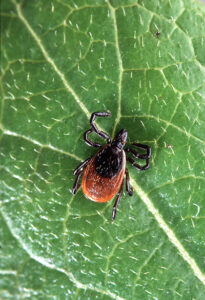Study led by Gardner and McBride shows ticks congregate in certain areas of ANP

With so many visitors, Acadia National Park is a hotspot location for exposure to tick borne diseases, which are on the rise in Maine. A new study from the University of Maine has found clusters of tick populations in the park, which could help inform prevention strategies for tick-borne illnesses like Lyme disease.
Former UMaine master’s student Sara McBride, now a medical entomologist for the Indiana Department of Health, and Allison Gardner, associate professor of arthropod vector biology at UMaine and Mitchell Center Faculty Fellow, led a team of researchers from UMaine, Cornell University and the National Park Service in overlaying tick surveys with ecological habitat feature data to model the risk of exposure to tick-borne disease in Acadia National Park. The researchers collected blacklegged ticks at 114 sites across the park over two years and mapped that data out on the park’s landscape features. The results showed that tick density varies significantly across the park, but is particularly high in areas with deciduous forest cover and relatively low elevation, especially the northeast area of Mount Desert Island.
“Understanding the spatial distribution of tick exposure risk in the park may ultimately inform practical environmental and public health management strategies,” says Gardner. “For example, the National Park Service could post informational signage in areas that have high tick densities, or build boardwalks in known tick habitat.”
Go to UMaine News for the complete article
